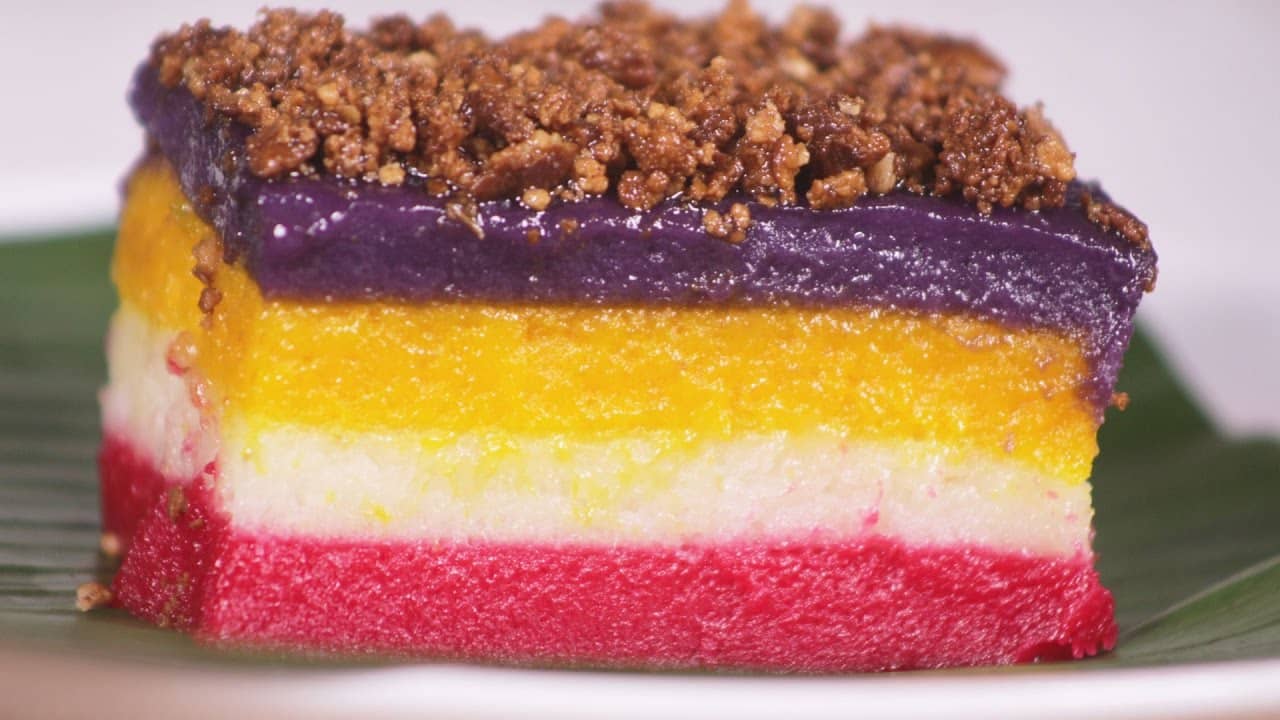In this guide, we’ll explore a selection of easy Filipino desserts that capture the essence of Filipino sweetness. Whether you’re craving something cool and refreshing or rich and creamy, these desserts are accessible to home cooks of all skill levels. Join us on a journey through the delightful world of Filipino sweets, where every bite is a celebration of flavor, tradition, and the joy of sharing good food with loved ones.
1- Halo-Halo:
This iconic Filipino dessert translates to “mix-mix” in English, which perfectly describes its preparation. It typically includes a combination of shaved ice, sweetened fruits like jackfruit, bananas, and sweet beans such as red beans and chickpeas. Other common ingredients are sweetened yams, tapioca pearls, jelly cubes, and leche flan. It’s then topped with a scoop of ube (purple yam) ice cream or sometimes just evaporated milk. Each bite offers a delightful mix of textures and flavors, making it a favorite during hot Philippine summers.
2- Buko Pandan:
This dessert features buko (young coconut) and pandan, a fragrant tropical plant. The buko is usually shredded and combined with pandan-flavored gelatin, which is often tinted green. Sweetened condensed milk or cream is sometimes added to enhance the richness. The dessert is served chilled and offers a refreshing taste of the tropics.
3- Leche Flan:
Often referred to as the Filipino version of crème caramel or flan, leche flan is a decadent dessert made from egg yolks, condensed milk, and vanilla extract. The mixture is poured into individual molds, caramelized with sugar, and then steamed until set. Once cooled, the dessert is inverted onto a plate, revealing its golden caramel topping. The texture is smooth, creamy, and indulgent, making it a popular choice for special occasions and celebrations.
4- Turon:
Turon is a sweet and crunchy Filipino snack made from ripe plantains or saba bananas, which are coated in brown sugar, wrapped in spring roll wrappers, and then fried until golden and crispy. Some variations also include strips of jackfruit or even sweet potato. The result is a delightful combination of caramelized sweetness from the bananas and a crispy outer shell. Turon is often enjoyed as a street food snack or dessert.
5- Bibingka:
This traditional Filipino rice cake is typically enjoyed during Christmas season but is also available year-round. It’s made from glutinous rice flour, coconut milk, sugar, and sometimes baking powder. The batter is poured into a clay pot lined with banana leaves, giving it a distinct aroma. It’s then baked until set and topped with salted eggs and grated coconut before serving. Bibingka offers a unique blend of sweetness and earthiness, making it a comforting and satisfying dessert.
6- Puto:
Puto are steamed rice cakes that come in various shapes and flavors. The basic ingredients include rice flour, sugar, and baking powder, which are mixed with water or coconut milk to form a smooth batter. The batter is then poured into small molds or cups and steamed until fluffy and cooked through. Puto can be enjoyed plain or topped with cheese, salted duck eggs, or grated coconut. They’re often served as a snack or dessert and are enjoyed by people of all ages.
7- Maja Blanca:
This creamy coconut pudding is a popular dessert in the Philippines, especially during fiestas and celebrations. It’s made from coconut milk, cornstarch, sugar, and sometimes condensed milk for extra richness. The mixture is cooked on the stovetop until thickened, then poured into a mold to set. Once chilled, it’s sliced into squares and topped with toasted coconut flakes or latik, which is a type of coconut caramel. Maja blanca is silky smooth, subtly sweet, and has a comforting coconut flavor that’s loved by many.
FAQs
What is a popular Filipino dessert?
One of the most popular Filipino desserts is “Halo-Halo.” This colorful and refreshing treat consists of shaved ice mixed with various sweet ingredients such as sweetened fruits, beans, jellies, and topped with a scoop of ice cream, leche flan, or ube (purple yam) halaya. It’s a beloved dessert enjoyed by people of all ages, especially during hot Philippine summers.
What is the national dessert of the Philippines?
While there is no official national dessert of the Philippines, “Leche Flan” is often considered one of the most iconic and beloved desserts in Filipino cuisine. This creamy caramel custard, made from egg yolks, condensed milk, and sugar, is a staple in celebrations and gatherings across the country. Its rich and silky texture, coupled with the caramelized sugar topping, makes it a quintessential Filipino indulgence.
What are the most popular Filipino cakes?
Some of the most popular Filipino cakes include:
-
- Ube Cake: Made with ube (purple yam), this vibrant cake features layers of moist ube-flavored sponge cake and ube buttercream frosting.
- Sans Rival: A decadent layered cake made with chewy meringue, buttercream, and chopped nuts, usually cashews.
- Mango Cake: A light and refreshing cake featuring layers of sponge cake, mango-flavored filling or puree, and whipped cream frosting, often topped with fresh mango slices.
- Chiffon Cake: A fluffy and airy cake made with vegetable oil, eggs, sugar, flour, and baking powder, often flavored with vanilla or pandan extract. It can be enjoyed plain or with various toppings and fillings.
What is the traditional sweet of the Philippines?
One of the traditional sweets of the Philippines is “Bibingka.” This classic rice cake is made from glutinous rice flour, coconut milk, sugar, and sometimes baking powder. It’s typically baked in a clay pot lined with banana leaves, giving it a distinctive aroma and flavor. Bibingka is often enjoyed during special occasions, particularly during Christmas season, and is beloved for its comforting and earthy sweetness.

